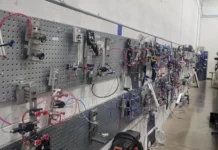The Original Equipment Suppliers Association (OESA) and manufacturing consulting firm Harbour Results, Inc., (HRI) recently released the results of their Q1 2019 Automotive Tooling Barometer. The study indicates the tooling industry is experiencing a soft start to 2019 with increased business anticipated in the second half of the year.
“We expect 2019 North American vendor tooling spend to be around $8 billion. However, there are a number of factors, including tariffs and automaker restructuring, that could significantly impact the industry and tooling spend,” said Laurie Harbour, president and CEO of HRI. “As a whole, the tooling industry is slow, but we are seeing some shops that remain busy – primarily because they have diversified their customer base.”
In Q1 2019, mold shops experienced a slight utilization increase of 2% compared to Q4 2018 (77% to 79%), while die shop utilization dropped drastically from 85% to 74% in the same timeframe. This decrease in the die market is due to the manufacturing industry slowdown. Because dies require a longer lead time than molds, it is an indicator that mold shop utilization likely will dip in the near future.
Work on hold continues to trend upward with an average of 12.6%, driven by several automotive program delays. Based on these factors, tool shop owner sentiment dropped to 62 %, the lowest point recorded since measurement started in Q1 2016.
The study also looked at shops’ investment strategies. Despite decreased revenue from 2017 to 2018 at both mold and die shops, both made clear efforts to invest in design talent in 2018. Additionally, in 2019, mold builders are planning to contribute 5.2% of revenue toward new capital expenditures, compared to 5.6% in 2018. In 2019, die builders expect to invest 4.0% of revenue, compared to 3.9% in 2018.
“Across the tooling industry we expect investment from 2018 to 2019 to remain relatively flat,” Harbour said. “Shops are investing money in improving their business, but much of the focus in on process improvement and software purchases such as CAM, scheduling and machine monitoring tools.”
Finally, the survey looked at shop profitability. Although still considered within the good range, because of the industry slowdown, on average tool shop profitability is down.
“With continued uncertainty throughout the automotive industry due to trade concerns, tariffs and program delays, we anticipated there would be a Tooling Barometer sentiment dip,” said Julie A. Fream, president and CEO, OESA. “We continue to work with OESA Tooling Council members to address these issues and increase tool shop involvement in OESA activities in Washington, DC. The upcoming MEMA/OESA Legislative Summit is an opportunity for tool shop owners to voice concerns directly with Congressional staffers on Capitol Hill.”
The survey population was comprised of mold shops (68%) and die shops (20%) in the US (45%), Canada (42%), Europe (7%) and Asia (3%). Shops with revenue ranges less than $5M up to greater than $40M were represented, with the largest percentage of shops coming from the $10-$20M (29%) range.
The OESA Automotive Tooling Barometer survey series was created by the OESA Tooling Council with the partnership of Harbour Results, Inc., to provide an indicator of the current state of the automotive tooling industry, and the perception of the near-term prospects for the industry. The OESA Automotive Tooling Barometer captures the sentiment of the major companies in this market.
For more information, visit www.harbourresults.com and www.oesa.org.




